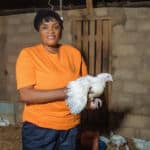Yunus Was Wrong — Savings, Not Credit, is a Human Right: Here’s How the Financial Inclusion Sector Can Shift its Focus
It was 1996, only weeks after the end of the Siege of Sarajevo during the Bosnian War. Amid the rubble of the war, Catholic Relief Services sent me to Bosnia as a consultant, to help launch a microfinance project there. In those days, microfinance was viewed by many development sector professionals as the silver bullet that would end poverty. I had my doubts about that, but I wasn’t aware of any viable alternatives. As the local Catholic Relief Services staff and I revised manuals and worked on the budget for yet another iteration of the standard microfinance model, I asked “How do Bosnians save and finance their businesses?” Their response: “Businesses have used zadrugas for generations to save and lend to each other.”
While most Bosnians know about zadrugas — a type of informal saving and lending group — I had never heard of them. And why should I? The microlending model I was promoting had worked (more or less) in scores of countries, yet I couldn’t help but ask myself: If zadrugas are so common in this community, and if our objective is to get capital to local businesses, why are we asking Bosnians to adopt microfinance models developed for market vendors and microenterprises in Africa, Asia and Latin America? Why not leverage the saving and lending model this community is already using successfully, and has been using for generations?
If I knew then what I know now, after more than 20 years evaluating and launching informal savings group initiatives and studying rotating savings and credit associations (ROSCAs) around the world, my consultancy in Bosnia would have taken a different turn. Rather than working to create a new microfinance institution (MFI) that would take on many of the roles zadrugas had traditionally played in the community, we would have asked the Catholic Relief Services staff to reach out to local zadrugas and enlisted the leaders of the best-managed and most-interested zadrugas to organize and support new groups.
I call this commonsense approach — starting with what is already working — the “low-friction” alternative. It’s based on understanding, and then supporting the growth of, local initiatives, by providing a small amount of outside funding and then fine-tuning and replicating those that have been most successful. Had we taken such an approach in Bosnia, the zadruga leaders — backed up by technical staff serving as catalysts rather than trainers, promoters and loan collectors — would have led the creation of more and higher-quality zadrugas to serve far more businesses, more sustainably and at a fraction of the cost.
Taking Savings Circles From Theory to Practice
Years later, in 2022, I was working in Lynn, Massachusetts — a city where roughly 40,000 of the 100,000 residents are Hispanic, largely immigrants from Guatemala and other Central American countries. Grassroots Finance Action, the not-for-profit that I direct, had launched a pilot project there, to see if encouraging ROSCA group leaders to train more groups could offer a simple way to boost financial inclusion. The goal of the project was to increase the number of Guatemalan immigrants investing in their informal savings circles (called “cuchubales” in the Guatemalan community). A few immigrants from other countries also joined.
Invited to Lynn by a local NGO, the Latino Support Network, we spoke to Guatemalan immigrants about their cuchubales. We found that while many attending the meeting were members of cuchubales, many were not. Of those who were not members, many said they were interested in joining.
Seeing the scale of the unmet demand, the Latino Support Network selected three Guatemalan women who had organized or been part of these savings circles in Lynn. Their task was to organize more cuchubales. They received a small, year-long stipend for their time. Within weeks, the three women had organized three new groups, using the same strategies they had long used in their home country and in Lynn.
As with the previously existing cuchubales in Lynn, each member of these newly formed savings circles agreed to invest $200 every week in their groups. In exchange for this disciplined saving, they received a lump sum payout that amounted to $4,800 after 24 weeks of saving in cuchubales with 24 members, and $8,000 after 40 weeks of saving in groups with 40 members — a transformational sum of money. As is typical for ROSCAs, a different member received the total collected by the entire group each week, progressing in turn until all had received their payouts. A $50 fee per member (about 1% of the payout) paid the organizers for the time they spent collecting and distributing the funds.
Asked what they liked about their cuchubales in a survey carried out by the Latino Support Network, many said, “It taught me to save. We can’t save in a bank — it is too easy to take our money out, and then there are all the fees and documentation.” Through the survey, we also learned that group members used their payouts to pay off debts to money lenders, payday loans and high-interest credit cards. They used the rest as a reserve for future expenses. Better-off members invested these funds in their businesses and homes.
The survey further revealed that:
- Only a fifth of group members had been members of cuchubales before: This shows the depth of the potential demand.
- 42% were low-income.
- 80% were women.
- All but two signed on for the second savings cycle — and for a third cycle that is currently underway.
- There was not a single delinquent payment: In these tight-knit communities, trust in each other is paramount.
The results of this approach clearly demonstrate its value: By the end of the third savings cycle, the cuchubal organizers in Lynn will have mobilized and distributed $1.5 million dollars, on average $20,000 per member over the three savings cycles. The size of these totals was surprising, as many group members lived on an income of roughly $30,000 per year. But as we learned, participating in the groups inspired members to take steps to maximize their savings: The lowest-income members earned extra income to make their payments, by taking on gig-economy jobs like driving for Grubhub, or requesting support from family members. Those who were saving more, $400 per week instead of $200, had higher-paying jobs. But regardless of their income, saving this much requires the members to watch every dollar: They cannot let the others down.
Impressive as these results are, they could be even greater with additional support. The current cuchubal organizers have already identified potential new organizers who have access to different networks than they do. They could train and support them, with some guidance and funding from an external organization.
But even without this additional support, the word is beginning to spread to other area communities: A delegation of Mayan women organizers working in fish processing plants in New Bedford, Massachusetts exchanged cuchubal strategies with the Lynn organizers, and within days had organized their own group, where 20 members are investing $100 each week — generating weekly payouts of $2,000. This simple model could be replicated nationwide and around the world: Indeed, Grassroots Finance Action has already received inquiries from Minneapolis, Nepal and Ghana, where community members are interested in creating their own savings groups.
Throughout history, transformational ideas often spread through word of mouth. Our strategy at Grassroots Finance Action aims to accelerate this peer-to-peer spread of ideas. The requirements? A little financial lubrication, recognition and support.
The Trillion Dollar Informal Financial System
The zadrugas of Bosnia and the cuchubales of Lynn are examples of a vast informal economic system that mobilizes and distributes a jaw-dropping trillion dollars every year. This estimate is based on the field research my graduate students from Brandeis and Columbia Universities and I have conducted, combined with data sets like the World Bank’s Findex21 report. This trillion dollars represents the sum of:
- The 419 million members of savings circles in developing countries — an estimate we extrapolated from the Findex21 study. We conservatively estimate that each member saves an average of $2 per week, or $100 per year. Collectively they mobilize and distribute at least US $42 billion each year.
- Our best guess is that one third — 83 million — of the quarter of a billion immigrants living in rich countries set aside money in savings circles. In New York City, research suggests that 74% of Mexican and 69% of Ecuadorian immigrants save informally, often via savings circles, so this could be an underestimate. Our own research shows that immigrants typically contribute at least $100 per week ($5,000 per year) to their savings circles — and often twice that amount. So we conservatively estimate that these immigrant savings circles contribute over $400 billion toward the trillion-dollar total.
- In addition, immigrants living in rich countries send home $529 billion in remittances to developing countries (more if remittances to other developed countries are counted). This is three times the total of official development assistance and foreign direct investment combined, but without the service delivery overhead. Furthermore, half of global remittances reach the rural areas where poverty is greatest and financial institutions are scarcest. While three quarters of remittances directly benefit families, the rest — over $100 billion per year — is saved or invested in productive activities that generate income or jobs, multiplying the economic development impact.
This informal financial system is based on trust instead of institutions, and it leverages the accumulated money management wisdom of millions of villagers and townsfolk, who lead rotating savings circles with similar models in countries around the world. Some of these savings groups (with 15 to 20 million members) are promoted by NGOs, principally in African villages, while others, most notably the Self-Help Groups in India, are facilitated by governments. But the vast majority, tens of millions of groups with easily 300 million members, are organized and run by local leaders acting independently without outside support. These groups are uniquely positioned to boost savings and extend financial inclusion among the more than 2 billion adults in the developing world who, according to the Findex21 report, do not save at all. With a little support they could reach many more.
Yet despite their importance — and the fact that they already do much of what we in the financial inclusion sector say we want to do — there is scarce recognition among financial inclusion practitioners that this informal system is worth consideration. This is puzzling, since those saving in informal groups and receiving remittances include many of the customers, and even many of the employees, of these institutional financial inclusion providers.
Nevertheless, it’s clear that villagers and townsfolk in developing countries, along with their loved ones who are living as immigrants in rich countries, are financing their own development. Some — often the comparatively better off, and those who live in cities and towns — use loans from MFIs and banks as part of their money management strategy. They are likely to use apps to send money, pay bills and take out loans. But the poorer the population, the less relevant (and more perilous) these formal financial inclusion tools are — especially when it comes to taking on debt. Contrary to the often-cited quote from Muhammad Yunus, it is savings, not credit, that is a “human right.”
Reversing the Financial Inclusion Paradigm
If the goal of financial inclusion is to provide people with easy access to useful amounts of capital and a safe, convenient place to save — whether this is from a financial institution or an informal savings circle — savings should be a higher priority than facilitating their access to more loans. This shift from credit to savings (including informal savings) would represent a reversal of the financial inclusion paradigm, as the sector has typically focused on credit-based approaches for increasing financial access through formal institutions.
Fortunately, the foundation for this paradigm shift already exists, in the form of the countless savings circles currently in operation around the world. The easiest way to reach non-savers is for the leaders of these existing savings circles to train new ones. Our experiences in Latin America, Africa and elsewhere show that with modest outside support, leaders can organize and support 10 to 15 new groups over three years.
This process could start with a network of pilot projects, focused on determining whether local leaders can successfully train more and higher-quality groups. Across the developing world there are hundreds of thousands (if not millions) of savings circle organizers who already lead quality groups and may be interested in expanding their reach. Local NGOs and other development organizations could identify and support them through a simple approach: Starting with this question, “How would you organize more savings circles in your community?” these organizations could select the group leaders who offer the best answers, providing them with modest funding and assistance to help organize them into teams, so they could learn from each other, monitor their progress and evaluate their outcomes.
According to Grassroots Finance Action’s estimates, involving 1 billion new members in these new savings groups would cost between $10 and $20 billion over the course of 10 years. This represents a very modest investment, considering that $580 billion will be spent on institutional financial inclusion over the next decade, if current yearly funding levels remain consistent. Yet except for some small investments in savings groups and Self-Help Groups, almost none of the sector’s roughly $58 billion in annual funding is currently being invested in this promising alternative.
Our estimates suggest that the newly organized savings groups would mobilize $50 – $100 billion in savings every year for the use of group members. With predictable pools of capital in hand, families would likely have more to eat, and more cash to navigate income volatility, launch enterprises, send their children to school and access health care. They would also build solidarity and mutual support within their groups — and over time, their financial activities within these groups would enable some members to gain access to institutional finance from formal providers.
A more modest objective — doubling the membership in informal savings circles to 840 million rather than adding 1 billion new members — would be even more feasible: At a cost of around $8 billion over five to 10 years, this could be accomplished for about 14% of the amount invested in institutional financial inclusion in a single year.
Despite the relatively minimal cost of scaling savings groups, this effort could lead to the development of a new approach to financial inclusion — one that includes the poor and poorest on a scale that is hard to imagine using our current models. All it takes is the humility to shift from talking to listening, learning from the existing financial systems created by the poor rather than trying to teach them to adopt our preferred approaches. As our motto at Grassroots Finance Action puts it, “They already have the answers, just ask.”
Jeffrey Ashe is an Adjunct Associate Professor for the School for International and Public Affairs at Columbia University and the Director of Grassroots Finance Action.
Photo credit: Jeffrey Ashe
- Categories
- Finance



